LD Systems MIX6AG2 and MIX6G2 – Practice Test (2/2) by Musiker Board
Through Musiker Board, I had the opportunity to test the LD Mix 6 AG2 setup with its extension box LD Mix 6 G2. Here they are:
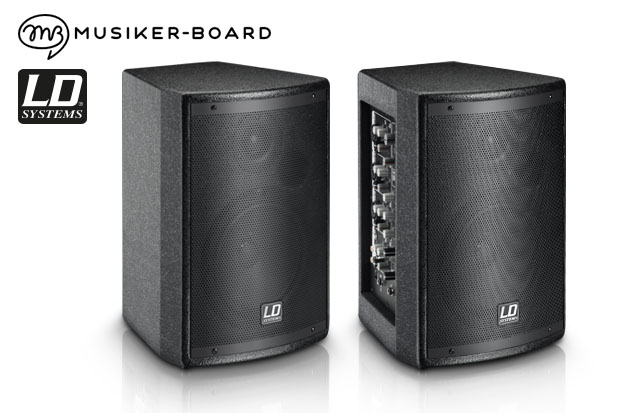
Following @mHs, who already carried out the first test in the PA sub-forum, I would like to explore another possibility: deployment as a small PA system or as a replacement for an acoustic amp in acoustic ensembles.
Even though I am very pleased with the elements overall, let me start with the niggles:
The speakers do have 2 tripod adapters each. Fantastic…but…they are designed for tubes with a 16 mm diameter. That doesn’t fit the usual 35 mm speaker stands or even microphone stands (15 mm). What a pity! An adjustable tilt would also not be a bad idea (especially in the transverse direction, because the speakers are literally begging to be used for a monitor application). The angular design of the cabinets is unfortunately not enough here. There are matching speaker stands for €25 from LD Systems.
The speaker connections are 6.3 mm jacks. Speaker cables are not included in the delivery. I had an old one in the basement that I had been using for makeshift wiring at home. Dear LD, please add a couple of euros to the price and provide at least a Speakon combo plug (Neutrik NLJ2 MD-H).
Neutrik NLJ2 MD-H 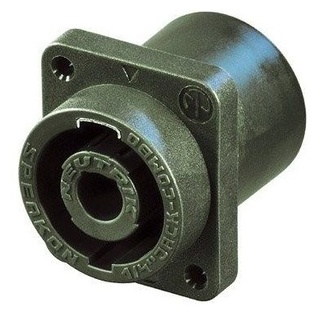
If necessary, a jack speaker connector will do the trick. The biggest danger is mistaking the monitor line out of the loudspeaker output for the passive second speaker and in doing so destroying the input of another active box. With a different-shaped socket, this kind of mishap could be avoided altogether.
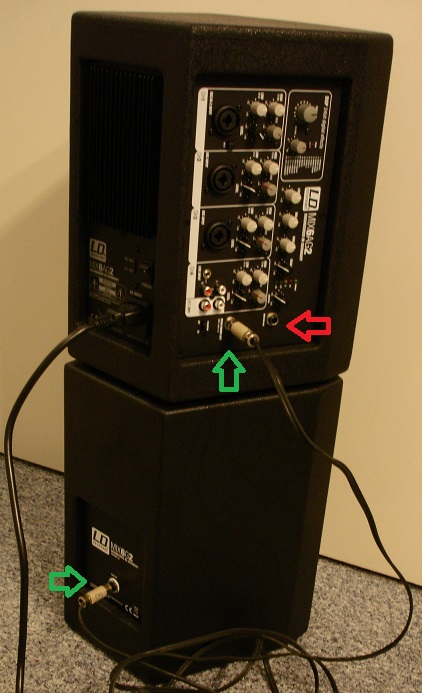
Here you can see the stack of active and passive speakers. Green arrows point to the speaker jacks, the red arrow shows the line monitor output. This is where you can make a mistake if you’re not careful. Phantom power on the microphone inputs. Can be switched together. Great! … Ahem, this is only 15 V nominal (14.6 V measured). There are of course condenser microphones which have a wide supply range. However, especially in the target group acoustic ensembles, there are surely many conventional condenser microphones that would not work properly in these conditions.
No 6.3 mm jack inputs on channel 4. Instead RCA and 3.5 mm stereo jack. Good for a party, but if you want to connect a keyboard or an amp modeller, you will need a special cable or an adapter cable. The small stereo jack is fine, but instead of RCA, I would prefer 2 x 6.3 mm jacks.
Enough ranting, now to the point.
I have several different speakers in my collection and am able to compare. The purpose is specifically to give an idea of what the speakers can do. My points of comparison are all significantly more expensive.
First, the small speakers from left to right: JBL Control 5, dB Technologies K300, LD Mix 6 G2 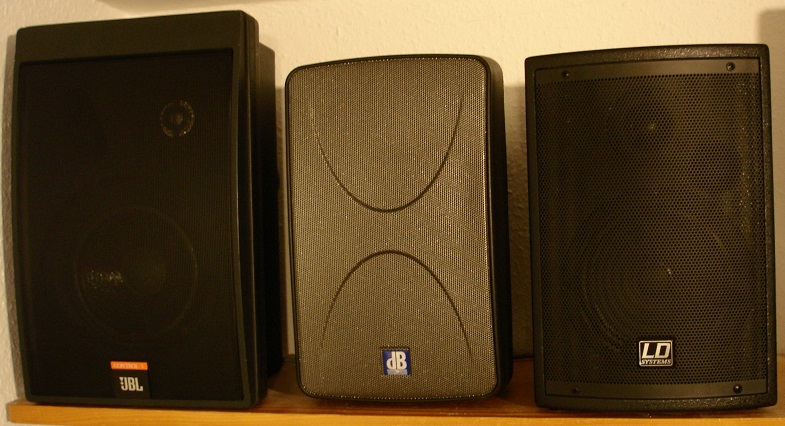
The Control 5 is much bigger, although it also has a 6.5″ woofer. The K300 is more slender (but deeper) with a 2 x 6.5″ woofer with a tweeter in between (arranged at an angle). The LD is a bass reflex system with dome tweeter, just like the Control 5.
JBL Control 5 2-way Loudspeaker
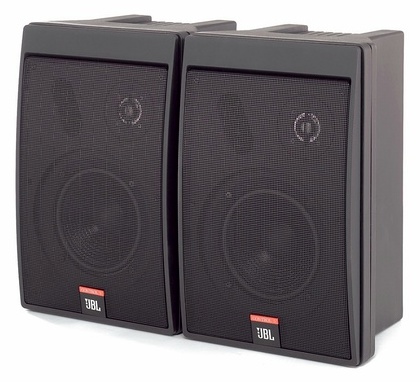
DB Technologies K 300
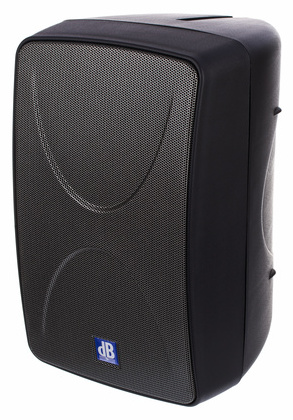
The other comparison: RCF ART310A against the LD model. An amazing difference in size between a 10″ and a 6.5″ speaker 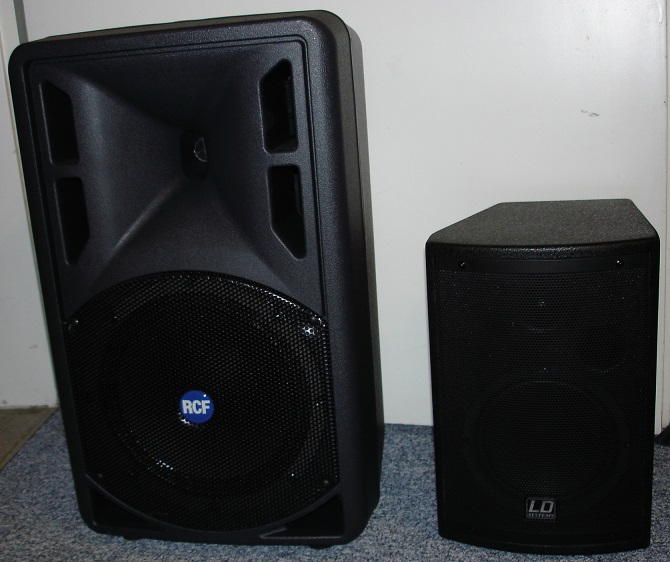
A first listening test: A (good quality) MP3 player via the 3.5 mm jack is connected and turned on: Not bad … More specifically, it sounds quite tidy and non-intrusive. The K300 for comparison via the monitor output: it sounds stronger in the mids and is probably more assertive within a band structure. Then the RCF ART310A connected to the monitor output. OK this one has more highs and more bass – but this comes as no surprise. I’ll come back to this setup later
The passive LD Mix 6 G2 on the stereo amplifier L-R in direct comparison to the Control 5: Here the class difference is clearly audible. The LD has a noticeably lower volume level (lower efficiency) and drops in the treble and bass compared to the JBL, which, however, is bigger in volume. Together with the higher capacity of the JBL (175 W for the JBL against 70 W for the LD, both on 4 ohms), the JBL should also score points in terms of higher volume level. The LD still sounds very enjoyable and neutral. Without measuring results, the LD should have a fairly flat frequency response, which is not a problem when it comes to feedback.
This is just for the record. The LD speakers do not sound bad at all. And together (1* active incl. mixer and effect + passive extension), they cost only as much as a K300 or a passive pair of Control 5.
Application purpose: This combo just screams: small acoustic ensemble! Singer-Songwriter. Substitute for an acoustic – amp. 1-2 singers with guitar(s). You could connect a 2nd guitar onto a stomp box and an adapter cable onto channel 4. The active speaker can be operated on its own of course, without any additional speaker. For this purpose, the active speaker is well equipped. 3 combined microphone/line channels and a stereo line channel (however, this is summed in mono). On top of this, an effects unit with predominantly reverb/echo programs.
Channel 1 has a Hi-Z switch, with which you can toggle the input to very high impedance. This works really well. Tested with a ukulele with a passive piezo system, an electric guitar, a jazz guitar and an electric bass guitar. The effect was convincing for all instruments (as expected). The piezo sounds stronger and the instruments with magnetic pickup with their little damped resonance provide the desired sound.
Without Hi-Z, all instruments sound lackluster. For instruments with built-in preamp, you do not need the high impedance input. They can then be switched on any input. What is also striking is that with an active Hi-Z, the volume increases. Probably the gain also changes, in addition to the input impedance.
Yes – indeed an E-bass. I didn’t expect it, because the speakers are only given for up to 80 Hz. Obviously, the loss is so moderate that you can actually use it to play the bass guitar without missing much. Not super loud, but for a little jam session in the living room at increased room volume, it is more than enough. (The K300 does not perform as well, although it is specified at 70 Hz).
The sound control per channel is fairly rudimentary with treble and bass. You don’t need a lot of tweaking for the sound anyway, since the basic sound is fine. With the treble, you can take out the sharpness or with a slight increase, improve the vocal clarity. With the bass, you can give a little more volume or reduce impact noise to increase speech intelligibility. But, larger corrections on instruments that need it are not available here. After all, you can also correct the mids at 2.5 kHz in the sum and customise a little to accommodate the room acoustics using the 3 existing bands.
There is only one volume controller per channel, no gain control. The circuit is probably designed so that the controller can be adjusted from 0 gain (nothing comes through) to maximum. Distortion is not an issue anyway, and I cannot complain about too much noise either.
The effect consists of reverb and echo programs, as well as 2 reverb+chorus programs. Namely, effects to thicken the sound somewhat, and make it sound nicer. Fits well with the application. Each channel has a separate controller and there is also a master controller for the effect. The effects cannot compete with a good effects processor, but for the purpose (acoustic ensemble), they are adequate, no frills or significant noise.
There remains only the Master controller for the overall volume. Ok. This is quite common. However, a nice and useful included freebie, is the Monitor output, which is picked up parallel to the main mix and has a dedicated controller. Here, you could connect a floor monitor, if you need it.
I would imagine a completely different application, however. The speaker is actually already a mixer and monitor, but maybe sometimes you need more power. In this case, I’d connect a powerful full-range PA speaker system to the monitor output for the sound and use the LD as monitor on a tripod, so that you can still easily access the buttons.
The craftsmanship is impeccable. The textured finish seems pretty resilient. I won’t put this to the test because I need to return the speakers.
The active speaker is quite heavy, the passive as you would expect for a box of this size.
I have tested all channels with different sources and discovered to my surprise that most of my condenser microphones work either with 9-52 V or from 12 V, i.e. they are actually good to use in this case.
What I would still like to achieve later would be to test how the pair perform at our trio rehearsal. I would like to test 1* guitar via modeller, 2* mikes and electric bass on the Hi-Z input (and there would also be a cajón or congas).
Just like my colleague @mHs, I come to the end result: The speakers will meet expectations for their intended use. You can get quite good value for the money
Areas of application:
-as replacement for an A guitar amplifier (e.g. the active speaker on its own)
– as mini PA for acoustic ensembles – as small PA for cabaret and street performers
– as a higher quality substitute for low-cost power mixer + speakers for schools, associations etc. and fairly simple in construction and operation.
– With the possibility to connect a larger PA speaker system to the “monitor” output, it allows for an excellent scalability for different situations.
– Whoever fits into one of the above categories and on a tight budget cannot go wrong with this set (or individual components).
Regards, Christoph
Source: Musiker-Board, 11.10.2014
___________________________________________
Also, we at LD Systems would like to thank “chris_kah” for this very successful review and wish him a lot of fun with our products!
For more information on the tested products MIX6AG2 and MIX6G2, as well as on the remaining Stinger G2 series, please visit:
http://www.ld-systems.com/en/series/stinger-g2-series/
Leave a Comment
You must be logged in to post a comment.











